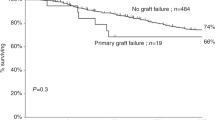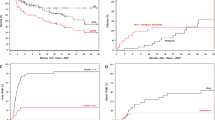Abstract
Allogeneic bone marrow transplantation (BMT) from an HLA-identical sibling donor is effective therapy for patients with bone marrow failure states and those with hematologic malignancies. However, only a minority of them will have an HLA-identical sibling donor; unrelated donors, matched or partially mismatched, have been used successfully for patients lacking a related donor. Even though results with allogeneic transplants using unrelated donors are encouraging, the incidence of complications including graft-versus-host disease (GVHD) and graft rejection or late graft failure is increased compared to identical sibling transplants. The combination of cyclophosphamide and total body irradiation (TBI) has been used as an effective preparative regimen for allogeneic transplants, however, the total dosage and dosing schedule of both the cyclophosphamide and TBI has varied significantly among studies. To decrease the rate of graft rejection and late graft failure with volunteer donors, we evaluated a preparative regimen of high-dose cyclophosphamide (200 mg/kg over 4 consecutive days, days −8, −7, −6, −5) followed by fractionated TBI (1400 cGy administered in eight fractions over 4 days, days −4, −3, −2, −1). GVHD prophylaxis included FK506 and methotrexate. From July 1993 to January 1996, 43 adult patients, median age 38 years (range 18–58 years), were treated with this preparative regimen. Seventeen patients had low-risk disease and 26 had high-risk disease. Thirty-one donor/recipient pairs were matched for HLA-A, -B, and -DR by serology and molecular typing. Seven additional pairs were minor mismatched at the HLA-A or HLA-B loci. Four other donor/recipient pairs were HLA-A,-B, and -DR identical by serology but allele mismatched at either DRB1 or DQB. Forty patients were evaluable for myeloid engraftment. Engraftment occurred in all 40 patients at a median of 19 days. There were no cases of graft rejection or late graft failure. Nephrotoxicity was the primary adverse event with 26 patients (60%) experiencing a doubling of their creatinine. Hepatic veno-occlusive disease occurred in seven patients, six of whom had high-risk disease. All patients who had relapsed or refractory disease prior to BMT achieved a complete remission following BMT. Six patients transplanted for high-risk disease relapsed a median of 377 days post-BMT. None of the patients with low-risk disease have relapsed following transplant; the Kaplan–Meier survival for those patients with low-risk disease is 62% and 37% for those patients transplanted with high-risk disease (P = 0.0129). The median Karnofsky performance status is 100% (range 70–100%). Therefore, a preparative regimen of high-dose cyclophosphamide and fractionated TBI is an acceptable regimen for patients receiving an allograft from unrelated donors.
This is a preview of subscription content, access via your institution
Access options
Subscribe to this journal
Receive 12 print issues and online access
$259.00 per year
only $21.58 per issue
Buy this article
- Purchase on Springer Link
- Instant access to full article PDF
Prices may be subject to local taxes which are calculated during checkout
Similar content being viewed by others
Author information
Authors and Affiliations
Rights and permissions
About this article
Cite this article
Geller, R., Devine, S., O’Toole, K. et al. Allogeneic bone marrow transplantation with matched unrelated donors for patients with hematologic malignancies using a preparative regimen of high-dose cyclophosphamide and fractionated total body irradiation. Bone Marrow Transplant 20, 219–225 (1997). https://doi.org/10.1038/sj.bmt.1700874
Received:
Accepted:
Issue Date:
DOI: https://doi.org/10.1038/sj.bmt.1700874
Keywords
This article is cited by
-
Efficiency of allogeneic hematopoietic SCT from HLA fully-matched non-sibling relatives: A new prospect of exploiting extended family search
Bone Marrow Transplantation (2015)
-
Fludarabine/i.v. BU conditioning regimen: myeloablative, reduced intensity or both?
Bone Marrow Transplantation (2008)



